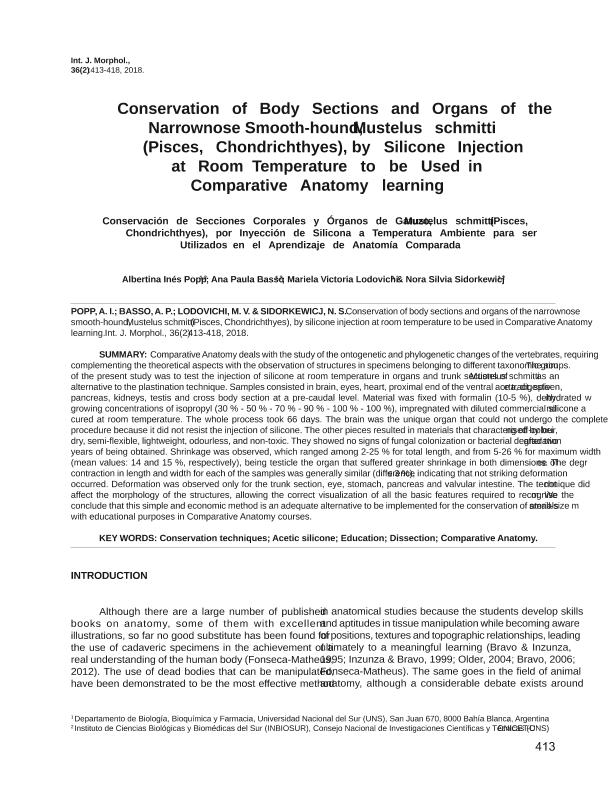Mostrar el registro sencillo del ítem
dc.contributor.author
Popp, Albertina Inés

dc.contributor.author
Basso, Ana Paula

dc.contributor.author
Lodovichi, Mariela Victoria

dc.contributor.author
Sidorkewicj, Nora Silvia

dc.date.available
2020-10-14T20:16:54Z
dc.date.issued
2018-06
dc.identifier.citation
Popp, Albertina Inés; Basso, Ana Paula; Lodovichi, Mariela Victoria; Sidorkewicj, Nora Silvia; Conservation of body sections and organs of the narrownose smooth-hound, Mustelus schmitti (Pisces, chondrichthyes), by silicone injection at room temperature to be used in comparative anatomy learning; Sociedad Chilena de Anatomía; International Journal of Morphology; 36; 2; 6-2018; 413-418
dc.identifier.issn
0717-9367
dc.identifier.uri
http://hdl.handle.net/11336/115920
dc.description.abstract
Comparative Anatomy deals with the study of the ontogenetic and phylogenetic changes of the vertebrates, requiring complementing the theoretical aspects with the observation of structures in specimens belonging to different taxonomic groups. The aim of the present study was to test the injection of silicone at room temperature in organs and trunk sections of Mustelus schmitti as an alternative to the plastination technique. Samples consisted in brain, eyes, heart, proximal end of the ventral aorta, digestive tract, spleen, pancreas, kidneys, testis and cross body section at a pre-caudal level. Material was fixed with formalin (10-5 %), dehydrated with growing concentrations of isopropyl (30 % - 50 % - 70 % - 90 % - 100 % - 100 %), impregnated with diluted commercial silicone and cured at room temperature. The whole process took 66 days. The brain was the unique organ that could not undergo the complete procedure because it did not resist the injection of silicone. The other pieces resulted in materials that characterised by being off-colour, dry, semi-flexible, lightweight, odourless, and non-toxic. They showed no signs of fungal colonization or bacterial degradation after two years of being obtained. Shrinkage was observed, which ranged among 2-25 % for total length, and from 5-26 % for maximum width (mean values: 14 and 15 %, respectively), being testicle the organ that suffered greater shrinkage in both dimensions. The degree of contraction in length and width for each of the samples was generally similar (difference £ 3 %), indicating that not striking deformation occurred. Deformation was observed only for the trunk section, eye, stomach, pancreas and valvular intestine. The technique did not affect the morphology of the structures, allowing the correct visualization of all the basic features required to recognise them. We conclude that this simple and economic method is an adequate alternative to be implemented for the conservation of small-size materials with educational purposes in Comparative Anatomy courses.
dc.format
application/pdf
dc.language.iso
eng
dc.publisher
Sociedad Chilena de Anatomía
dc.rights
info:eu-repo/semantics/openAccess
dc.rights.uri
https://creativecommons.org/licenses/by-nc/2.5/ar/
dc.subject
ACETIC SILICONE
dc.subject
COMPARATIVE ANATOMY
dc.subject
CONSERVATION TECHNIQUES
dc.subject
DISSECTION
dc.subject
EDUCATION
dc.subject.classification
Otros Tópicos Biológicos

dc.subject.classification
Ciencias Biológicas

dc.subject.classification
CIENCIAS NATURALES Y EXACTAS

dc.title
Conservation of body sections and organs of the narrownose smooth-hound, Mustelus schmitti (Pisces, chondrichthyes), by silicone injection at room temperature to be used in comparative anatomy learning
dc.title
Conservación de secciones corporales y órganos de gatuzo, mustelus schmitti (Pisces, chondrichthyes), por inyección de silicona a temperatura ambiente para ser utilizados en el aprendizaje de anatomía comparada
dc.type
info:eu-repo/semantics/article
dc.type
info:ar-repo/semantics/artículo
dc.type
info:eu-repo/semantics/publishedVersion
dc.date.updated
2020-10-06T17:49:41Z
dc.identifier.eissn
0717-9502
dc.journal.volume
36
dc.journal.number
2
dc.journal.pagination
413-418
dc.journal.pais
Chile

dc.journal.ciudad
Temuco
dc.description.fil
Fil: Popp, Albertina Inés. Consejo Nacional de Investigaciones Científicas y Técnicas. Centro Científico Tecnológico Conicet - Bahía Blanca. Instituto de Ciencias Biológicas y Biomédicas del Sur. Universidad Nacional del Sur. Departamento de Biología, Bioquímica y Farmacia. Instituto de Ciencias Biológicas y Biomédicas del Sur; Argentina
dc.description.fil
Fil: Basso, Ana Paula. Consejo Nacional de Investigaciones Científicas y Técnicas. Centro Científico Tecnológico Conicet - Bahía Blanca. Instituto de Ciencias Biológicas y Biomédicas del Sur. Universidad Nacional del Sur. Departamento de Biología, Bioquímica y Farmacia. Instituto de Ciencias Biológicas y Biomédicas del Sur; Argentina
dc.description.fil
Fil: Lodovichi, Mariela Victoria. Universidad Nacional del Sur. Departamento de Biología, Bioquímica y Farmacia; Argentina. Consejo Nacional de Investigaciones Científicas y Técnicas; Argentina
dc.description.fil
Fil: Sidorkewicj, Nora Silvia. Consejo Nacional de Investigaciones Científicas y Técnicas. Centro Científico Tecnológico Conicet - Bahía Blanca. Instituto de Ciencias Biológicas y Biomédicas del Sur. Universidad Nacional del Sur. Departamento de Biología, Bioquímica y Farmacia. Instituto de Ciencias Biológicas y Biomédicas del Sur; Argentina. Universidad Nacional del Sur. Departamento de Biología, Bioquímica y Farmacia; Argentina
dc.journal.title
International Journal of Morphology

dc.relation.alternativeid
info:eu-repo/semantics/altIdentifier/url/http://www.intjmorphol.com/wp-content/uploads/2018/06/art_06_362.pdf
dc.relation.alternativeid
info:eu-repo/semantics/altIdentifier/doi/http://dx.doi.org/10.4067/S0717-95022018000200413
Archivos asociados
